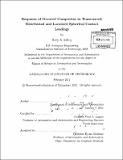Response of grooved composites to transversely distributed and localized spherical contact loadings
Author(s)
Jeffrey, Holly K
DownloadFull printable version (35.64Mb)
Other Contributors
Massachusetts Institute of Technology. Dept. of Aeronautics and Astronautics.
Advisor
Paul A. Lagacé.
Terms of use
Metadata
Show full item recordAbstract
The response of a grooved composite specimen to two contact loading situations is studied; load applied via a transversely oriented cylindrical indenter and via a localized spherical ball-ended indenter. The philosophy of the Building Block Approach is used to develop these tests in the current study in that the cylindrical indenter creates a "two-dimensional loading" (transversely distributed) case, and the spherical indenter adds complexity to the system and creates a "three-dimensional loading" (localized spherical) case. The final failure and initial permanent deformation, in the form of crushing, is investigated, along with the effect of laminate configurations and ply angles. The is done by using the two indenters, six different laminates, and two types of tests to study the grooved composite specimens, 1 inch wide by 2 inches long, of 78 to 80 plies. This work uses a specimen configuration and testing technique developed in previous work. A computed microtomography technique is used to examine select specimens to ascertain the extent of the internal damage. Specimens subjected to the "two-dimensional loading" case exhibit four Behavior Types of the load-stroke response. Several aspects of the response are used to characterize the Behavior Types, including initial linear regions, knee loads, reverse knee loads, second linear regions, and changes in slopes. The responses of the two loading cases indicate that the details of the laminate play a significant role in the load-stroke response for the "two-dimensional loading" case, whereas the details of the loading play a more significant role for the "three-dimensional loading" where only one type of load-stroke behavior is generally displayed. In the "three-dimensional loading" case, significant crushing occurs which is not seen in the "two-dimensional loading" case. This is visible due to the localized loading for the "three-dimensional loading" case, and impacts the overall load-stroke response. The 900 plies, in addition to the "mesh" created by the ply angles in the laminate, and the "ply angle mismatch" within a laminate, affect the ability of the laminate to resist indentation and the load-stroke response. Recommendations for further work are presented.
Description
Thesis (S.M.)--Massachusetts Institute of Technology, Dept. of Aeronautics and Astronautics, 2011. Cataloged from PDF version of thesis. Includes bibliographical references (p. 133-135).
Date issued
2011Department
Massachusetts Institute of Technology. Department of Aeronautics and AstronauticsPublisher
Massachusetts Institute of Technology
Keywords
Aeronautics and Astronautics.